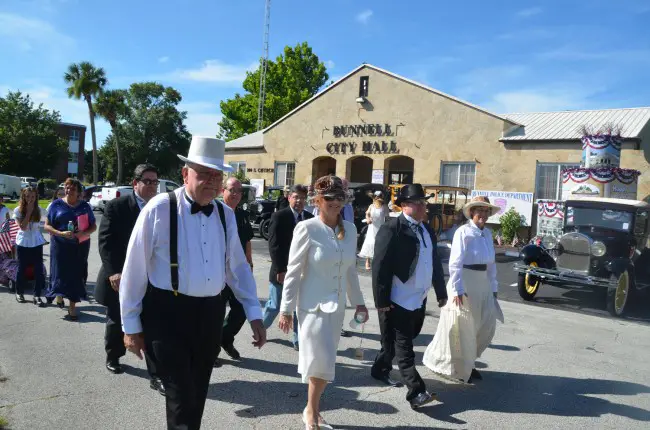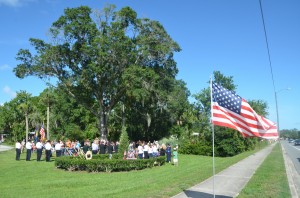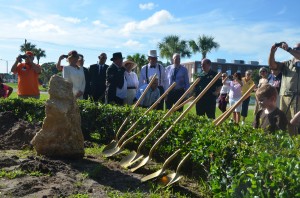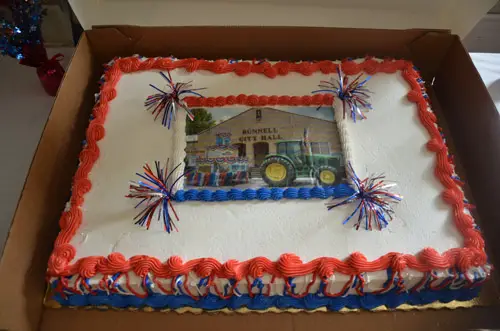
Well, Downton Abbey, meet the Bunnell Centennial: if it’s lavish costumes you wanted, vintage cars, even period politics—including the reenactment of the very first meeting of the Bunnell City Council, as it was then called—it was all there Monday as the county’s second-smallest city but one of the state’s oldest celebrated its centennial.
Every one of the current city commissioners and many city staffers went to Hollywood-like lengths to dress the part of their forebears, some of them renting items from tux stores, others chancing on their Gatsby wardrobe at a specialty store in Miami, and all of them, despite the tortuous layers, bearing the heat worthy of the days of Genesis as they stood and spoke through a nearly hour-long ceremony under the summer sun to bury a time capsule.
The 14 by 10 by 18 inch metallic box is not to be opened until 2063, or 50 years from now, when the city celebrates its sesquicentennial, assuming Palm Coast hasn’t declared itself Northeast Florida’s only city by then.

And when, as Mayor Catherine Robinson put it, “memories of this year will come flooding back.” (Not all memories: some of them may not be too flattering.) Included in the time capsule: a birthday card signed by city staff and residents, business cards from city staffers, the centennial pin and mug designed to sell and fund the celebration, flyers of special events that led up to today’s celebration, pictures, the city seal, newspaper clippings, the city’s first plat map, a memento of Eddie Johnson, the national soccer star and Bunnell native (whose grandmother Edith was in attendance today), and nine essays by Bunnell children on why history is important for Bunnell.
“History,” one of the students wrote, citing the railroad, farming that made Bunnell and improvements in the housing industry year after year, “is everything.”
“The only way we can understand who we are and how we got to be where we are is by studying history,” another wrote.
Imagine what a full history of Bunnell would tell. The 1939 edition of the WPA Guide to Florida reserves just one mention to the old town, when its population was 671, describing it as “a lumber and turpentine town [that] lies in the heart of an extensive potato-growing area. From January to March an important industry is the cutting and shipping of palmetto leaves used in Palm Sunday ceremonies. Averaging 3 feet in length, the leaves are piled on wert sand and covered with damp burlap while awaiting shipment; so protected, they remain fresh for several months.”
That world is not entirely gone: agriculture still defines Bunnell’s outward boundaries, even if turpentine and palmetto leaves don’t.

As Robinson and Diane Marquis spoke of the capsule near its burial plot, city and county commissioners and an honor guard wilting in the sun next to them—some of the people in attendance were almost contemporaries with the city—a crowd of about 75 huddled in the shade of an oak until it was over. But isn’t, quite: the ceremony was followed by another commemoration on the grounds of Carver Gym a few blocks south, where the local Flagler chapter of the Kiwanis Club’s $5,000 donation and a Rotary Club of Flagler Beach donation of $24,000 will help fund multi-purpose sports fields in land around the gym, which the city owns. The donations cover more than half the $56,000 project.
Then it was back to the old Bunnell City Hall (now its police department and community hall) for the reenactment of the inaugural 1913 meeting of the Bunnell City Council, when its members were Mayor W.C. Heath, Councilmen George Moody, I.I. Moody, W.H. Cochran, Ed Johnson and J.F Lambert. Robinson—who, near the time capsule grounds, had audibly let it be known that she was not going to stand for a men-only photo op) was to be Mayor Heath.

According to a transcript of the proceedings prepared for the occasion, I.I. Moody nominated Lambert to chair that meeting. I.I. Moody, who—like all Moodies in town, were the makers and shakers—moved that the mayor also be the municipal judge. All approved. The council then took on the business of passing ordinances one after the other (who was to be town marshal, tax collector, tax assessor and so on), without so much as inviting the public to speak, or following the order of placing ordinances on subsequent agendas for second or third readings: so it went back then when meetings were more like formalities of decisions already reached by men (there were no women) to whom the only sunshine law was that requiring a hat on brighter days.
There were no surprise moves by either Moody to fire the city manager, and no one was lynched.
Monday evening, the most important decision of the commission—the modern commission—was to end the proceedings and dive into a centennial cake.






























Perry Mitrano says
Great article Flagler Live.
I’m proud to be a part of the history on this day. Maybe, someday in the future 50 years from now the Next- Gen-Hyper-Google will pull up this article and folks will be reading about it one more time.
Happy Birthday City of Bunnell
Geezer says
That’s a nice picture with the Bunnellian politicians strutting around in their costumes.
It’s the epitome of a rogues’ gallery.
A.S.F. says
Public prayer and lavish costumes…They sure do like being taken seriously!
north ditch says
I hope they have a similar celebration when Martinez finally leaves……free Bunnell!
I'll take the brick road says
I wish they had put Martinez in the time capsule…..or at least his UNRENEWED contract!
popo3984 says
hopefully somebody can save the city of bunnell and get these commissioners to change their mind unless they want bunnell to go back about 15 years !!!!!!!!!!!!!!!!!!
north ditch says
15 years ago we didn’t have a Mariela boat lift refugee in charge….!